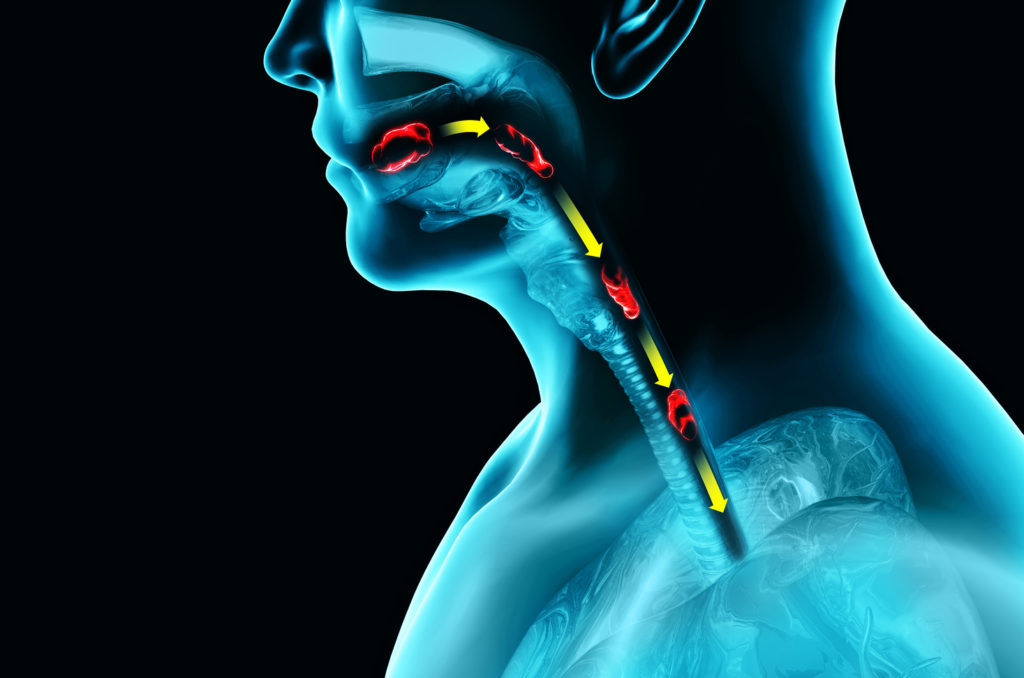
In this series, we ask dietitians across Canada to answer your questions on nutrition and dietary support.
We recently spoke with Kirstin Wingate, a registered dietitian based in Vancouver, BC.
This month, Kirstin answers dietary questions related to EoE, a type of food allergy that affects the gastrointestinal/digestive tract.
Are there specific foods that irritate the throat/digestive system that should be avoided, and are there foods that help with EoE?

For people diagnosed with EoE, we know that food proteins can drive the inflammation of the esophagus, and that food elimination diets can be effective treatment. The most common food triggers of EoE in North America are milk, wheat/gluten, soy, egg, peanut/tree nuts, and fish/shellfish*. If you would like to try an elimination diet as treatment of your EoE, you can discuss this option with your gastroenterologist.
If you prefer to use medication as treatment of your EoE then you do not need to avoid certain foods. Individuals with EoE sometimes have their own food preferences based on experiences and symptoms they’ve had with foods in the past. They may prefer to avoid foods they have had trouble swallowing in the past, but those vary from person to person.
*Crustaceans (e.g., lobster, shrimp) and molluscs (e.g., scallops, clams) are sometimes collectively referred to as shellfish.
Can you explain the focus on wheat vs gluten in elimination diets?

The short answer is that a wheat elimination diet is more specific (one grain only) and that gluten is a broader category (it is found in other grains as well). Wheat is the grain commonly used in foods like bread, pasta, etc., and it naturally contains many different types of protein. Gluten is a type of protein found in wheat that is also found in barley and rye. We know that wheat is the second-most common trigger of EoE (after milk) and that eliminating it as part of a food elimination diet can be an effective treatment. Usually this is done as just a wheat elimination, without eliminating rye and barley as well.
However, there is a theoretical risk that if someone has wheat as a trigger for their EoE, they could also react to gluten that is found in rye and barley. If you are starting an elimination diet for treatment of your EoE, it’s important to discuss the plan with your dietitian and gastroenterologist so everyone is in agreement with what should be avoided in your diet. If you have any confusion about what food you should be eliminating, whether it be for EoE, celiac disease, or food allergy, then ask your healthcare professional for advice.
What are the different types of elimination diets for treatment of EoE?
Elimination diets for treatment of EoE try to balance the effectiveness of the treatment with the difficulty of implementing it. The most effective elimination diet is the most difficult one to do; it is called the elemental diet and involves drinking a specialty formula instead of eating regular foods. There is also the six food elimination diet which involves eating regular food but avoiding the six most common allergens: milk, wheat/gluten, soy, egg, peanut/tree nuts, fish/shellfish. Other elimination diets include: the four food elimination diet (milk, wheat/gluten, soy, egg), the one food elimination diet (milk) and the ‘step-up’ elimination diet (begins with milk and wheat/gluten elimination).
For more details on the types of elimination diets, watch the recording of our “Understanding EoE” webinar with Dr. Vishal Avinashi and Kirstin Wingate.
What can be done if reactions/symptoms still occur even while following the six food elimination diet?
It can be worthwhile to make note of your symptoms so you can give a detailed update to your gastroenterologist when you see them next. If your symptoms are persistent and impacting your ability to eat well and enjoy life, then you may want to discuss other treatment options with your doctor. In the meantime, depending on the type of symptoms you are having, you may find it helpful to have small frequent meals, give yourself enough time to eat slowly, take sips of water with your food, chew well, choose soft foods, and/or avoid problematic foods.
Do you have a question you’d like to ask a dietitian in the months to come? If so, please send it along to us at info@foodallergycanada.ca.
Please note: The dietitians featured in this series answer questions on general topics, please talk to your doctor if you have questions about your own health or the health of your child.
Tags: ask the dietitian, EoE, Eosinophilic Esophagitis
